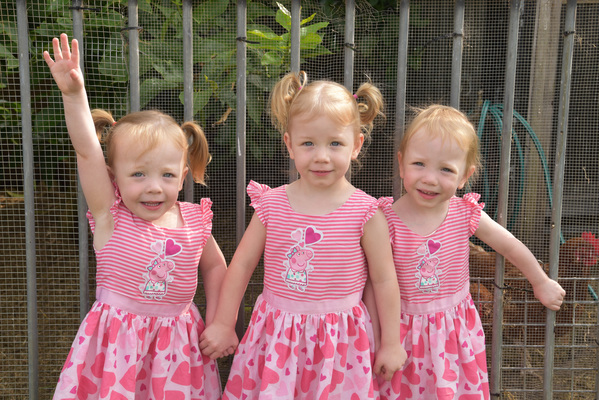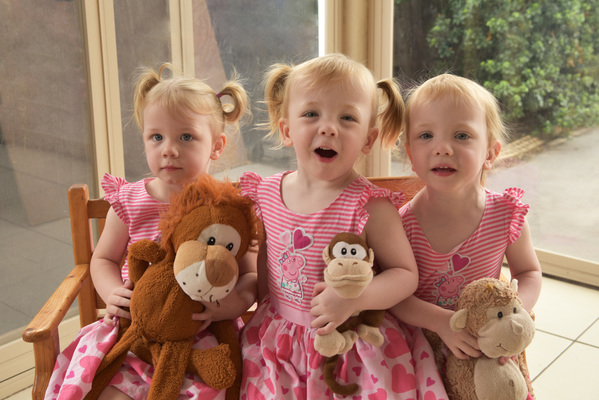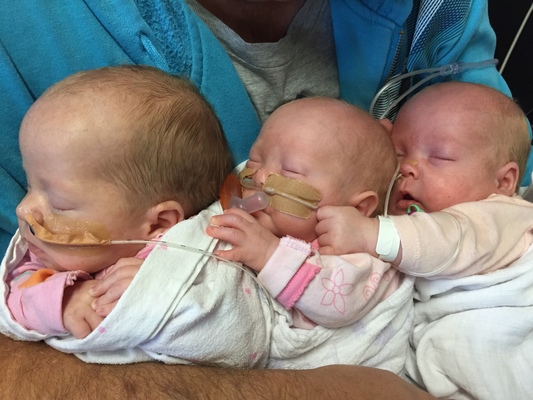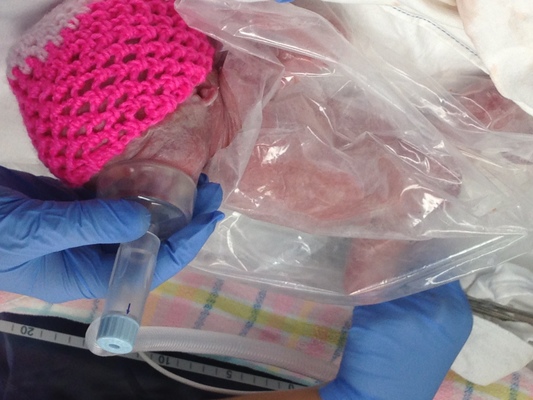By Melissa Dorries
Asha, Jade and Sophie Temby are three little miracles who defied extraordinary odds just by being born.
The tough triplets turn 3 on March 30 – an incredible milestone given medical experts said there was no chance they would all be delivered alive.
The girls weighed a combined 3.879kg when they were born at 30 weeks and had a rocky start to life.
After a heartbreaking medical diagnosis early in their pregnancy, Megan and Adam were advised to abort two of the girls to save one.
Two of the triplets were sharing a placenta and had developed Twin to Twin Transfusion Syndrome (TTTS). The disease results in one baby getting too much blood flow and the other not enough, causing one to accumulate fluid in their sac and leaving the other without fluid.
The disease is deadly – if left untreated the odds of survival are, at best, 10 per cent.
Shortly after discovering she was expecting, Megan strongly suspected she was going to have a challenging pregnancy.
She felt much sicker than when she was pregnant with her two boys, Lachlan, now aged 11, and Dylan, 9.
In fact, she felt so sick she actually thought she was having four babies.
“I went to the GP and demanded a scan,” she said.
“I had my first scan at eight weeks – I was relieved there weren’t four babies.
At the routine 12-week scan, the triplets were growing well and Megan was told to come back for another scan at 20 weeks.
Feeling uncomfortable with the lengthy gap between scans, Megan and Adam contacted a major hospital and were linked to a high-risk foetal monitoring clinic.
The 16-week appointment was the first time they became aware of TTTS and the risk to identical babies. Megan was feeling very uncomfortable and her stomach had really popped out – an early warning sign of increased fluid levels.
The girls sharing a placenta already had already progressed to Stage 1 of TTTS – a serious diagnosis requiring urgent treatment.
The Tembys were told about an amazing procedure called fetal laser surgery which cuts off blood connections to try and equal our the share of blood flow between babies.
But sadly their hopes of having the surgery were quickly dashed. The procedure wasn’t possible as cords had grown into Sophie’s placental wall.
The prognosis was grim.
“They said ‘do you want to terminate so save one?” Megan said.
“There are only five surgeons in Melbourne who could do the procedure, so I said ‘can you put our case out there?’
“Four of them said to terminate and save one because there’s just no chance (all would survive). One said to let nature take its course, so they thought they wouldn’t survive.“
“TTTS has a 90-100% fatality rate and we were at the extreme end due to it developing so early and (them) being triplets and the cords growing into Sophie’s placental wall.“
After being given the devastating news, Megan and Adam decided to wait a week before making any decisions on the future of their babies.
When they had their next scan, the TTTS had progressed to Stage 2.
Specialists told the Tembys to consider the possibility of long-term disabilities and the danger that one of the girls would die in the womb and give another a stroke.There was also a chance the girls could develop Twin anemia polycythemia sequence (TAPS), a chronic form of TTTS.
“They were saying if you want to walk away with one, then terminate,” Megan said.
“We just went back every week. Every time they were expecting the little one (Jade) not to have a heartbeat.
“At 24 weeks Jade wasn’t growing. They didn’t think she wouldn’t reach the 500 gram mark.
“There were long-term disabilities they wanted us to think about.
“Jade, if she passed, could give Asha a stroke.”
Delivery wasn’t an option until all the girls weighed at least half a kilogram.
So, as tough as it was, the Tembys decided to continue and let nature take its course.
Then at 28 weeks, the incredible happened – tiniest triplet Jade made it over 500 grams.
Two weeks later, doctors decided it was time for a c-section delivery.
The girls were born one minute apart at Monash Medical Centre on the morning of March 30, 2016.
Asha tipped the scales at 1.391kg, Sophie weighed 1.424kg and Jade was the smallest at 1.064kg.
But they weren’t out of the woods yet.
The girls spent the first two months of their little lives in intensive care, and another month in hospital.
Asha was the first to come home. Sophie joined her three days later, but was sent back to hospital for a week after catching bronchiolitis.
Jade came home for weeks later but remained on a feeding tube.
The Temby’s case has amazed medical experts.
The girls not only survived but have no serious long-term health issues.
Apart from Jade facing some growth delays and Asha having some fluid on the brain, the Temby triplets are healthy.
“I cannot praise the Monash (Medical Centre) enough. They saved the triplets lives after they were born – it was touch and go when they were born,” Megan said.
Looking at the Temby triplets, you would have no idea they had such a difficult start to life.
The trio are outgoing, cheeky and love tearing around their bikes in their Skye backyard.
Each have different personalities.
“Asha is the very sporty, cheeky and an outgoing girl. She loves to also dress up and is a real girly girl,“ Megan said.
“Sophie is the boss and organiser. She is really observant and catches onto new things so quickly.
“Jade is very tough and very cheeky. If there is mischief to get up to Jade usually starts it.
“If anyone is up to trouble it is always Jade and Asha working together, with Sophie always telling them off.“
As the girls go from strength to strength, Megan is on a mission to raise awareness about TTTS, a disease few parents are aware of.
She wants parents expecting identical multiples to be aware of the condition and demand regular scans.
“The mortality rate is 90-100 per cent,” she said.
“Anyone with identical babies needs fortnightly scans early on into the pregnancy.
“We are so incredibly lucky.”















